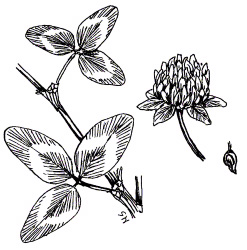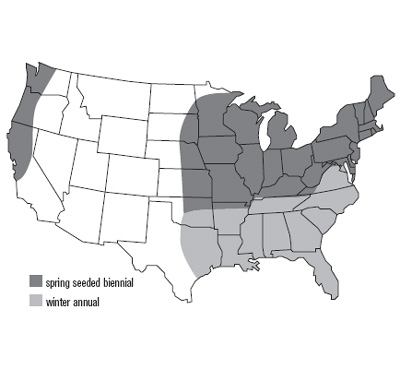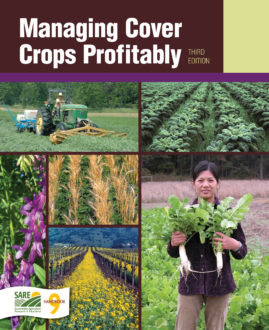
Red Clover (Trifolium pratense)
Also called: medium red clover (multi-cut, early blooming, June clover); mammoth clover (singlecut, late blooming, Michigan red)
Type: short-lived perennial, biennial or winter annual legume
Roles: N source, soil builder, weed suppressor, insectary crop, forage
Mix with: small grains, sweetclover, corn, soybeans, vegetables, grass forages
See charts for rankings and management summary.
Red clover is a dependable, low-cost, readily available workhorse that is winter hardy in much of the U.S. (Hardiness Zone 4 and warmer). Easily overseeded or frostseeded into standing crops, it creates loamy topsoil, adds a moderate amount of N, helps to suppress weeds and breaks up heavy soil. Its most common uses include forage, grazing, seed harvest, plowdown N and, in warmer areas, hay. It’s a great legume to frostseed or interseed with small grains where you can harvest grain as well as provide weed suppression and manage N.
Benefits of Red Clover Cover Crops

Crop fertility. As a cover crop, red clover is used primarily as a legume green manure killed ahead of corn or vegetable crops planted in early summer. Full-season, over-wintered red clover can produce 2 to 4 T dry matter/A and fix 70 to 150 lb. N/A. In Ohio, over-wintered mammoth and medium red clover contained about 75 lb. N/A by May 15, increasing to 130 lb. N by June 22 (366).
Two years of testing in Wisconsin showed that conventionally planted corn following red clover yielded the same as corn supplied with 160 lb. N/A, with less risk of post-harvest N leaching. Corn and the soil testing showed that 50 percent of the cover crop N was released in the first month after incorporation, corresponding well with corn’s fertility demand. Post-harvest soil N levels in the clover plots were the same or less than the fertilized plots, and about the same as unfertilized plots (401).
Widely adapted. While many other legumes can grow quicker, produce more biomass and fix more nitrogen, few are adapted to as many soil types and temperate climatic niches as red clover. As a rule, red clover grows well wherever corn grows well. It does best in cool conditions.
In southern Canada and the northern U.S., and in the higher elevations of the Southeast and West, red clover grows as a biennial or short-lived perennial. At lower elevations in the Southeast, it grows as a winter annual, and at lower elevations in the West and Canada, it grows under irrigation as a biennial (120). It grows in any loam or clay soil, responding best to well drained, fertile soils, but also tolerates less well drained conditions.
Many economic uses. Red clover has been a popular, multi-use crop since European immigrant farmers brought it to North America in the 1500s. It remains an important crop thanks to its greater adaptability, lower seeding cost and easier establishment than alfalfa. It can produce up to 8,000 lb. biomass/A.
A red clover/small grain mix has been a traditional pairing that continues to be profitable. A rotation of corn and oats companion-seeded with red clover proved as profitable as continuous corn receiving 160 lb. N/A in a four-year Wisconsin study (400). For more information, see the Wisconsin Integrated Cropping Systems Trial (449) and the final report of this project, partially funded by SARE (328).
Red clover was the most profitable of five legumes under both seeding methods in the trial—sequentially planted after oats harvest or companion planted with oats in early spring. The companion seedings yielded nearly twice as much estimated fertilizer replacement value as the sequential seedings. The work showed that red clover holds great potential to reduce fertilizer N use for corn grown in rotation (401).
In Michigan, red clover frost-seeded into winter wheat suppressed common ragweed growth through wheat harvest and into the summer. The red clover did not provide complete ragweed control, but there was no adverse effect on wheat yield (297).
Red clover sown as a companion with spring oats outperformed the other legumes, which suffered from insect damage, mechanical damage during oat harvest and slow subsequent regrowth. The short season proved inadequate for sequentially seeded legumes with the exception of hairy vetch, which was nearly as profitable as the red clover (400).
The role of red clover’s N contribution in the rotation grew more significant as N prices increased in the late 1990s (and 2007!), even though clover seed price also increased from the original 1989 calculations (398).
Soil conditioner. Red clover is an excellent soil conditioner, with an extensive root system that permeates the topsoil. Its taproot may penetrate several feet.
Attracts beneficial insects. Red clover earned a co-starring role with LOUISIANA S-1 white clover in pecan orchard recommendations from Oklahoma State University. Red clover attracts more beneficials than white clover, which features higher N fixation and greater flood tolerance than red clover (261).
Two Types of Red Clover
Two distinct types of red clover have evolved from the same species. Be sure you plant a multicut cultivar if you plan to make more than one green manure cutting, or to maintain the stand to prepare for a late-summer vegetable planting.
Medium red clover. Medium red (some call it multi-cut) grows back quickly, and can be cut once late in the seeding year and twice the following year. For optimum N benefit and flexible cropping options from the planting (allowing it to overwinter as a soil-protecting mulch), you can use it for hay, grazing or seed throughout the second season. Seed may be up to 25 percent more expensive than single-cut. See Chart 3B: Planting.
Mammoth red clover produces significant biomass and as much N as medium red in a single first cutting, but does not produce as much total biomass and N as medium red’s multiple cuttings over time. Use this “single-cut” red clover where a field will be all-clover just during the seeding year. Slow-growing mammoth doesn’t bloom the establishment year and regrows quite slowly after cutting, but can provide good biomass by the end of even one growing season.
A single cutting of mammoth will give slightly more biomass—at a slightly lower cost—than a single cutting of medium red. Where multiple cuttings or groundcover are needed in the second season, medium red clover’s higher seed cost is easily justified (197).
Some types of mammoth do better overseeded into wheat than into oats. ALTASWEDE (Canadian) mammoth is not as shade tolerant as MICHIGAN mammoth, but works well when seeded with oats. MICHIGAN mammoth shows the best vigor when frostseeded into wheat, but is not as productive as medium red (229).
Management of Red Clover Cover Crops
Establishment & Fieldwork for Red Clover Cover Crops
In spring in cool climates, red clover germinates in about seven days—quicker than many legumes—but seedlings develop slowly, similar to winter annual legumes. Traditionally it is drilled at 10 to 12 lb./A with spring-sown grains, using auxiliary or “grass seed” drill boxes. Wisconsin researchers who have worked for several years to optimize returns from red clover/oats interseedings say planting oats at 3 to 4 bu./A gives good stands of clover without sacrificing grain yield (398).
Red clover’s tolerance of shade and its ability to germinate down to 41° F give it a remarkable range of establishment niches.
It can be overseeded at 10 to 12 lb./A into:
- Dormant winter grains before ground thaws. This “frostseeding” method relies on movement of the freeze-thaw cycle to work seed into sufficient seed-soil contact for germination. If the soil is level and firm, you can broadcast seed over snow cover on level terrain. You can seed the clover with urea if fertilizer application is uniform (229). Use just enough N fertilizer to support proven small grain yields, because excess N application will hinder clover establishment. To reduce small grain competition with clover in early spring, graze or clip the small grain in early spring just before the stems begin to grow (120).Hoof impact from grazing also helps ensure seed-to-soil contact.
- Summer annuals such as oats, barley, spelt or spring wheat before grain emergence.
- Corn at layby. Wait until corn is 10 to 12 inches tall, and at least 6 weeks (check labels!) after application of pre-emergent herbicides such as atrazine. Clover sown earlier in favorable cooler conditions with more light may compete too much for water. Later, the clover will grow more slowly and not add substantial biomass until after corn harvest lets light enter (197). Dairy producers often broadcast red clover after corn silage harvest.
- After wheat harvest. Red clover logged a fertilizer replacement value of 36 lb. N/A in a two year Michigan trial that used N isotopes to track nitrogen fixation. Red clover and three other legumes were no-till drilled into wheat stubble in August, then chemically killed by mid-May just ahead of no-till corn. Clover even in this short niche shows good potential to suppress weeds and reduce N fertilizer application (140).
- Soybeans at leaf-yellowing. Sowing the clover seed with annual or perennial ryegrass as a nurse crop keeps the soil from drying out until the clover becomes established (197).
Whenever possible, lightly incorporate clover seed with a harrow. Wait at least six weeks (check labels!) to establish a red clover stand in soil treated with pre-emergent herbicides such as atrazine.
Killing Red Clover Cover Crops
For peak N contribution, kill red clover at about mid-bloom in spring of its second season. If you can’t wait that long, kill it earlier to plant field corn or early vegetables. If you want to harvest the first cutting for hay, compost or mulch, kill the regrowth in late summer as green manure for fall vegetables (197). If avoiding escapes or clover regrowth is most important, terminate as soon as soil conditions allow.
Actively growing red clover can be difficult to kill mechanically, but light fall chisel plowing followed by a second such treatment has worked well in sandy loam Michigan soils.
To kill clover mechanically in spring, you can till, chop or mow it any time after blooming starts. You can also shallow plow, or use a moldboard plow. Chop (using a rolling stalk chopper), flail or sicklebar mow about seven to 10 days ahead of no-till planting, or use herbicides. Roundup Ready® soybeans can be drilled into living red clover and sprayed later.
A summer mowing can make it easier to kill red clover with herbicides in fall. Michigan recommendations call for mowing (from mid-August in northern Michigan to early September in southern Michigan), then allowing regrowth for four weeks before spraying. The daytime high air temperature should be above 60° F (so that the plants are actively growing). When soil temperature drops below 50° F, biological decomposition slows to the point that mineralization of N from the clover roots and top-growth nearly stops (229).
Field Evaluation of Red Clover Cover Crops
In Michigan, about half of the total N fixed by a legume will mineralize during the following growing season and be available to that season’s crop (229). However, Wisconsin research shows release may be faster. There, red clover and hairy vetch released 70 to 75 percent of their N in the first season (401).
Rotations for Red Clover Cover Crops
Rotation niches for red clover are usually between two non-leguminous crops seeding with oats or frostseeding into wheat or barley are common options (34). The intersowing allows economic use of the land while the clover is developing. This grain/red clover combination often follows corn, but also can follow rice, sugar beets, tobacco or potatoes in two-year rotations. For three-year rotations including two full years of red clover, the clover can be incorporated or surface-applied (clipped and left on the field) for green manure, cut for mulch or harvested for hay (120).
Red clover in a corn>soybean>wheat/red clover rotation in a reduced-input system out-performed continuous corn in a four-year Wisconsin study. The legume cover crop system used no commercial fertilizer, no insecticides and herbicides on only two occasions—once to-spot spray Canada thistles and once as a rescue treatment for soybeans. Rotary hoeing and cultivating provided weed control.
Gross margins were $169 for the corn>soybeans> wheat/red clover and $126 for continuous corn using standard agricultural fertilizers, insecticides and herbicides. Top profit in the study went to a corn>soybean rotation with a gross margin of $186, using standard inputs (272, 398, 167).
Ohio farmer Rich Bennett frostseeds redclover (10-12 lb./A) into wheat in February. He gets a decent stand of clover that keeps weeds down in summer after wheat harvest. The clover overwinters and continues to grow in spring. He waits as long as possible, and then kills the clover with a disc and roll (two passes) in late April and plants corn. He doesn’t add any fertilizer N and the corn averages 165 bu/A on his Ottokee fine sandy soil.
If summer annual grasses are a problem, red clover is not your best option because it allows the grasses to set seed, even under a mowing regime.
Pest Management for Red Clover Cover Crops
If poor establishment or winterkill leads to weed growth that can’t be suppressed with clipping or grazing, evaluate whether the anticipated cover crop benefits warrant weed control. Take care to completely kill the cover crop when planting dry beans or soybeans after clover. Unless you are using herbicide-tolerant crops, you have limited herbicide options to control clover escapes that survive in the bean crop (229).
Root rots and foliar diseases typically kill common medium red clover in its second year, making it function more like a biennial than a perennial. Disease-resistant cultivars that persist three to four years cost 20 to 40 cents more per pound and are unnecessary for most green manure applications. When fertilizer N cost is high, however, remember that second-year production for some improved varieties is up to 50 percent greater than for common varieties.
Bud blight can be transmitted to soybeans by volunteer clover plants.
Other Management Options for Red Clover Cover Crops
Mow or allow grazing of red clover four to six weeks before frost in its establishment year to prepare it for overwintering. Remove clippings for green manure or forage to prevent plant disease. Red clover reaches its prime feeding value at five to 15 days after first bloom.
Under ideal conditions, medium red clover can be cut four times, mammoth only once. Maximum cutting of medium one year will come at the expense of second-year yield and stand longevity. Red clover and red clover/grass mixtures make good silage if wilted slightly before ensiling or if other preservative techniques are used (120).
If an emergency forage cut is needed, harvest red clover in early summer, then broadcast and lightly incorporate millet seed with a tine harrow or disk. Millet is a heat-loving grass used as a cover and forage in warm-soil areas of Zone 6 and warmer.
Comparative Notes
Medium red clover has similar upper-limit pH tolerance as other clovers at about 7.2. It is generally listed as tolerating a minimum pH of 6.0—not quite as low as mammoth, white or alsike (Trifolium hybridum) clovers at 5.5—but it is said to do well in Florida at the lower pH. Red clover and sweetclover both perform best on well-drained soils, but will tolerate poorly drained soils. Alsike thrives in wet soils.
Red clover has less tendency to leach phosphorus (P) in fall than some non-legume covers. It released only one-third to one-fifth the P of annual ryegrass and oilseed radish, which is a winterannual brassica cover crop that scavenges large amounts of N. Figuring the radish release rates— even balanced somewhat by the erosion suppression of the covers—researchers determined that P runoff potential from a quick-leaching cover crop can be as great as for unincorporated manure (274).
For early fall plowdown, alsike clover may be a cheaper N source than mammoth, assuming similar N yields.
Red clover and alfalfa showed multi-year benefits to succeeding corn crops, justifying a credit of 90 lb. N/A the first year for red clover (197) and 50 lb. N/A the second year. The third legume in the trial, birdsfoot trefoil (Lotus corniculatus), was the only one of the three that had enough third-year N contribution to warrant a credit of 25 lb. N/A (148).
Cultivars. KENLAND, KENSTAR, ARLINGTON, and MARATHON are improved varieties of medium red clover with specific resistance to anthracnose and mosaic virus strains. They can persist three or even four years with ideal winter snow cover (90). CHEROKEE has performed well in Iowa (384), is suited to the Coastal Plain and lower South, and has superior resistance to rootknot nematode.
